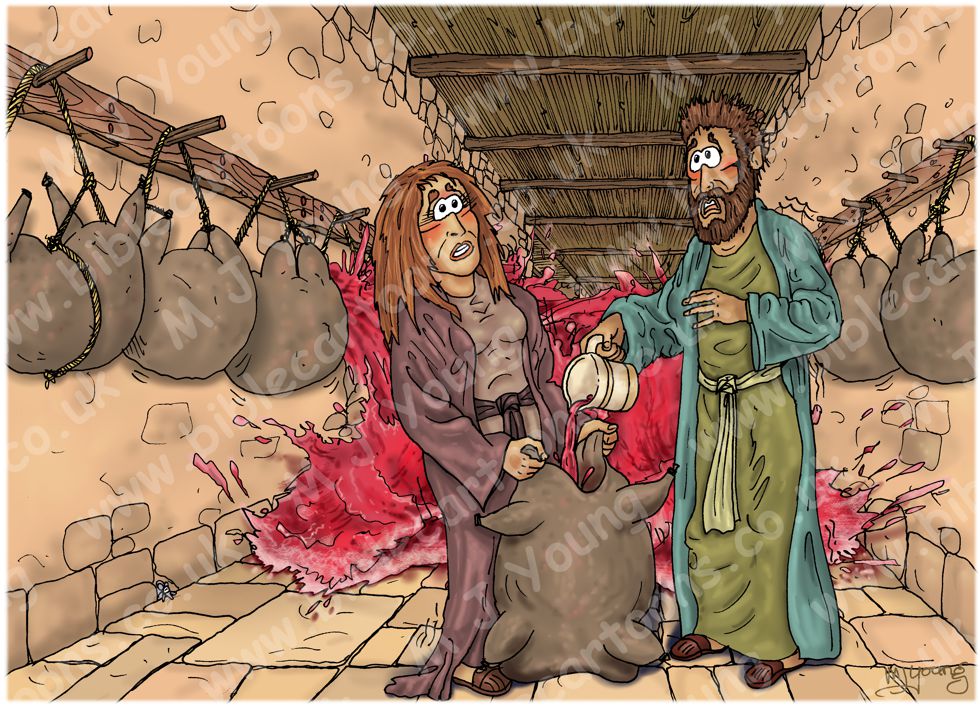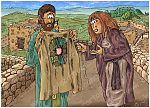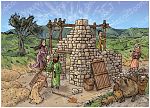Bible Cartoon: Luke 05 - Parable of new wine into old wineskins
Click on Add to cart button below shopping cart.
Purchased Bible Cartoons do not have watermarks. Links to Cartoons provided on email once purchase is completed.Bible Book: Luke
Bible Book Code: 4200503701
Scene no: 2 of 2
Bible Reference & Cartoon Description
Luke 5:37-39 (NLT)
37 “And no one puts new wine into old wineskins. For the new wine would burst the wineskins, spilling the wine and ruining the skins. 38 New wine must be stored in new wineskins. 39 But no one who drinks the old wine seems to want the new wine. ‘The old is just fine,’ they say.”
DRAWING NOTES:
TIME OF DAY:
Unspecified in the Bible narrative. Daytime.
LIGHTING NOTES:
The sun illuminate this scene (situated behind the viewer), casting shadows below and behind the figure and objects.
CHARACTERS PRESENT:
A woman holding an old wineskin. A man pouring new red wine into the old wineskin.
A grey mouse.
RESEARCH/ADDITIONAL NOTES:
This scene shows a woman pouring new wine into an old wineskin, held by a man. I imagine they are working in a winery; the long corridor behind them has wooden pegs on the walls, upon which the wineskins are hung and stored. I have drawn the same couple I drew in the previous scene “Luke 05 – Parable of new cloth on old robe”, since these scenes are related.
As I pointed out in Matthew & Mark’s gospel drawings of these scenes, the new wine expands as it ferments, increasing the pressure in its container (if the container is sealed). If a new wineskin is used as that container, then its elasticity can handle the fermentation-induced expansion. But, if new wine is poured into an old wineskin (that has lost its elasticity), then the fermenting wine would burst the old wineskin, and all the wine stored in it would be lost.
In my drawing the man & woman are looking alarmed as they hear the wineskins (hanging up on wooden pegs on the wall) bursting,& a tsunami of red wine hurtling towards them along the corridor! This is easier to appreciated in the image below, which has the figures removed.
Here is the scene without the figures in the foreground, including the wine and wineskins.
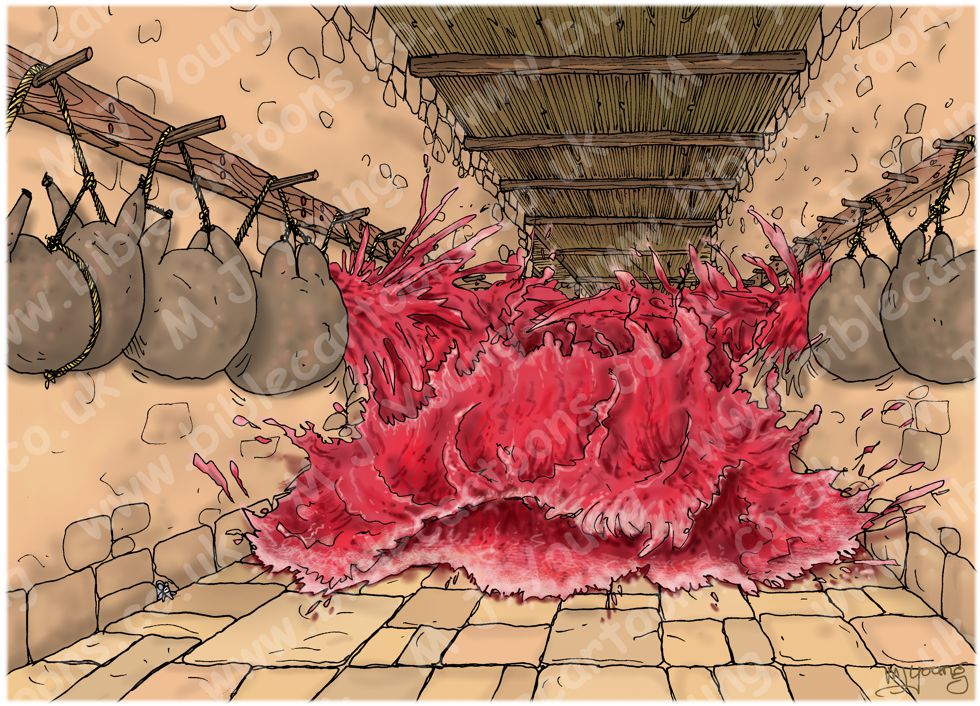
Background of Mark 05 – Parable of new wine into old wineskins with wine
Here is the scene without the figures, wine or wineskins in the foreground.
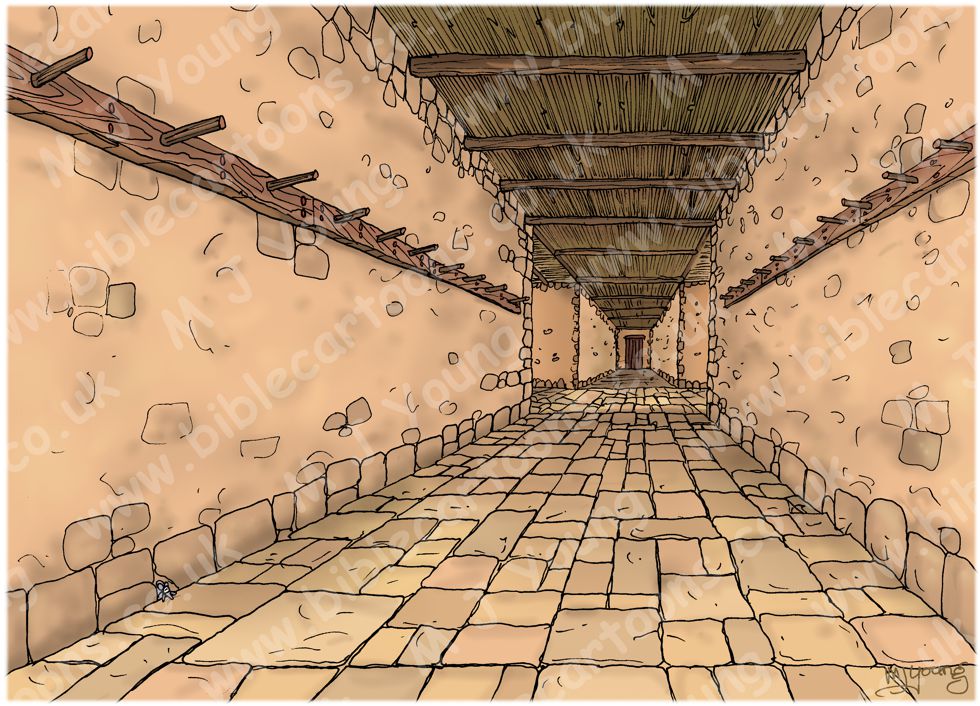
Background of Mark 05 – Parable of new wine into old wineskins
Click on the colour bar below to view/buy this Background:
Background of Luke 05 – Parable of new wine into old wineskins
Jesus (In this parable) is again emphasizing the fact that He is doing something new. The old religious experiences and expectations (e.g. the expectation that everyone must fast on certain days set by the religious leadership) proved inadequate for 1st Century believers. Jesus was ushering in a new series of expectations: it was time to adjust them. Jesus’ ministry was clearly not going to fit into preconceived ideas and tired rituals of the past. Like the wine exploding out of the old wineskins, an inflexible adherence to the old ways and traditions would result in spiritual loss.
Luke’s Gospel provides an additional statement Jesus made (not mentioned in Matthew and Mark’s accounts) concerning this parable: “And no one after drinking old wine wants the new, for they say, ‘The old is better’” (Luke 5:39). This shows the attitude shown by John’s disciples and the Pharisees. To paraphrase, we could say, “Those (such as the Pharisees) who love their old rituals and personalized traditions will find the new commandments of Christ to be distasteful. It’s natural to cling to the old ways, just as it is natural to prefer aged wine over new wine.”
You just can’t mix old religious rituals with new faith in Jesus. Jesus fulfilled the law; therefore, there is no longer any need to continue in it. There is even less need to continue with old, man-made rituals. Jesus cannot be added to a works-based religion: “I do not set aside the grace of God; for if righteousness comes through the law, then Christ died in vain” (Galatians 2:21, NKJV).
A note about wineskins.
In the 1st century, wineskins were watertight bags made from animal hides (most commonly goatskins), which were crafted from the entire skin of an animal, or else several animals, sewn together. The skin(s) was cleaned and tanned, and any seams were treated with resin, to make them watertight. The neck of the skin was tied shut to hold the wine. A strap (perhaps of twine, rope or cloth) was used for carrying the wineskin.
The elasticity of a new wineskin was essential to contain the pressure of new, fermenting wine, while an old, dry, and stretched wineskin would crack and burst under the strain. The only way to use an empty, old wineskin (which was stiff and brittle), would be to soak it and treat with oil to soften it before re-use.
Purchase
Low qlty Bible Cartoon
